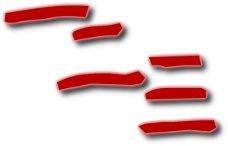Mandarin Chinese word order
Mandarin Chinese word order is similar to English in a lot of ways. The basic word order is subject + verb + object (known as SVO), as it is in English. There are a lot of important differences though.
[ ](/china/mandarin/cmn-grammar/word-order/attachment/mandarin-word-order-yi-er-san/” rel="attachment wp-att-4996)
](/china/mandarin/cmn-grammar/word-order/attachment/mandarin-word-order-yi-er-san/” rel="attachment wp-att-4996)
This page goes through Mandarin Chinese word order from very basic sentences up to sentences with many elements. The end result is:
Sbj + Tme + Mnr + Plc + Neg + Aux + Vrb + Cmp + Obj
That’s a generalised word order for simple Mandarin Chinese sentences. It’s not concrete, but works most of the time with some important caveats.
Building up Mandarin Chinese word order
As mentioned above, basic Mandarin word order is SVO: subject + verb + object. Remember that this is just what’s typical in Mandarin. Different word orders can certainly appear.
One major reason for this is that the idea of a “subject” isn’t as clear in Mandarin as it is in many other languages. The subject is often omitted, and Mandarin is more interested in the topic of a sentence; it’s a topic-prominent language.
Still, SVO is a good place to start. Here are some examples of basic Mandarin SVO sentences, colour coded for subject (red), verb (green) and object (blue).
我 爱你。 Wǒ ài nǐ. I love you.
他 喜欢猫。 Tā xǐhuan māo. He likes cats.
你 吃面条。 Nǐ chī miàntiáo. You eat noodles.
他们 去公园。 Tāmen qù gōngyuán. They go to the park.
As you can see from the colour coding, the word order of these basic sentences is the same in Mandarin and English.
Auxiliary verbs
Auxiliary verbs are also known as helper verbs. English is full of them, and so is Mandarin. In Mandarin, auxiliary verbs are placed before the main verb just as they are in English.
Some more examples, with the auxiliary verb colour coded in purple.
她 会说中文。 Tā huì shuō zhōngwén. She can speak Chinese.
他们 可以帮助你。 Tāmen kěyǐ bāngzhù nǐ. They can help you.
Negation
English is a bit funny about negation. It doesn’t like negating main verbs, so if there isn’t an auxiliary verb it will insert one and negate that. In Mandarin you can just negate the main verb (negation colour coded in pink):
我 不喜欢他。 Wǒ bù xǐhuan tā. I don’t like him.
他们 不吃肉。 Tāmen bù chī ròu. They don’t eat meat.
她 不喝咖啡。 Tā bù hē kāfēi. She doesn’t drink coffee.
When there is an auxiliary verb, Mandarin prefers to negate that. Some examples:
他们 不会说中文。 Tāmen bù huì shuō zhōngwén. They can not speak Chinese.
她 不要去。 Tā bùyào qù. She will not go.
我 不应该告诉你。 Wǒ bù yìng gāi gàosu nǐ. I should not tell you.
Note how in English the negation occurs after what’s being negated (the auxiliary verb in the examples above), whereas in Chinese it comes before. This is because of a general rule in Chinese: modifiers precede what they modify (see below).
Adverbials: time, manner and place
See also: Time, manner, place (Mandarin adverbial order)
The structure is getting a little more complicated now. Words that add information about the verb such as time, manner and place are known as adverbials.
In Mandarin these nearly always come before the verb. This is different to English which tends to put them all over the place depending on the situation.
Another difference between the two languages is that Mandarin has a specific order for this extra information: time first, then manner and then place. This sequence is a general rule.
Some examples with adverbials in turquoise:
我 明天要去上海。 Wǒ míngtiān yào qù shànghǎi. I will go to Shanghai tomorrow.
他 慢慢地吃饭。 Tā màn man de chī fàn. He eats slowly.
你 在这里等我。 Nǐ zài zhèlǐ děng wǒ. Wait for me here.
我 今天下午用电邮发。 Wǒ jīntiān xiàwǔ yòng diànyóu fā. I will send it by email this afternoon.
我们 意外地在箱子里找到了一只猫。 Wǒmen yìwàide zài xiāngzi lǐ zhǎodàole yī zhī māo. We unexpectedly found a cat in the box.
我 上个星期匆匆地在我的房间里看了四本书。 Wǒ shàng gè xīngqí cōngcōngde zài wǒ de fángjiān lǐ kànle sì běnshū. Last week I quickly read four books in my room.
Complements
Complements are a tricky topic in grammar. Mandarin has a few kinds of special complements that come after the verb: directional, degree, result and potential.
The grammar of these is pretty complicated. The main point in terms of word order is that they occur after the verb.
Some examples with complements marked in orange:
我 会下来。 Wǒ huì xiàlái. I will come down.
他 说得很好。 Tā shuō de hěn hǎo. He speaks well.
我 看到了他。 Wǒ kàndàole tā. I saw him.
她 听得懂。 Tā tīng dé dǒng. She understands.
A note on adjectives
Adjectives are placed before what they modify, as in English. This follows the general Chinese rule of modifiers preceding what they modify.
Some example sentences with adjectives colour coded in turquoise (as they are modifiers just like adverbials):
所有人 都喜欢大的比萨。 Suǒyǒu rén dōu xǐhuan dà de bǐsà. Everyone likes big pizzas.
瘦的 男人杀死了胖的男人。 Shòu de nánrén shā sǐle pàng de nánrén. The thin man killed the fat man.
那辆 红色的汽车撞到了蓝色的卡车。 Nà liàng hóngsè de qìchē zhuàng dàole lánsè de kǎchē. That red car hit the blue van.
Complete Mandarin word order
(for simple sentences!)
This is a general word order for Mandarin that works most of the time. Note that Mandarin sentences are not always exactly like this, especially due to Mandarin being topic-prominent. Adjectives could be inserted before the subject and object:
Sbj + Tme + Mnr + Plc + Neg + Aux + Vrb + Cmp + Obj
(subject, adverbials, negative, auxiliary verb, verb, complement, object)
Sources and further reading
- [Mandarin Chinese: A Functional Reference Grammar - Amazon](http://www.amazon.co.uk/gp/product/0520066103/ref=as_li_ss_tl?ie=UTF8&tag=easasistu-21&linkCode=as2&camp=1634&creative=19450&creativeASIN=0520066103" rel="external nofollow “Mandarin Chinese: A Functional Reference Grammar [Paperback]")
- Mandarin grammar - Wikipedia
- Mandarin Chinese sentence structure - About.com
